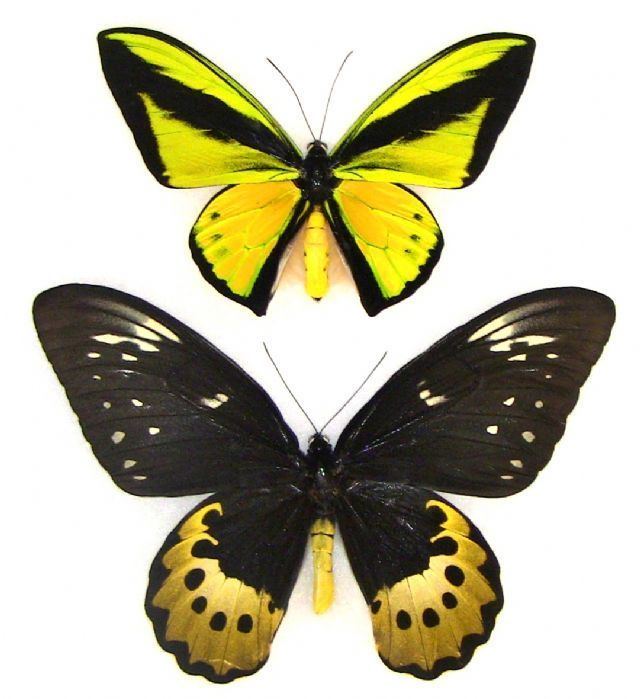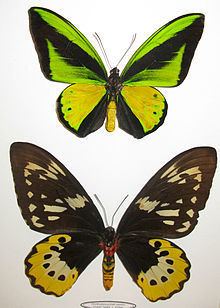Family Papilionidae Genus Ornithoptera Order Butterflies and moths | Tribe Troidini Scientific name Ornithoptera goliath Rank Species | |
 | ||
Similar Ornithoptera priamus, Ornithoptera paradisea, Ornithoptera tithonus, Ornithoptera croesus, Rothschild's birdwing | ||
Ornithoptera goliath 1
Ornithoptera goliath, the Goliath birdwing, is a birdwing butterfly found in New Guinea. It is the second largest butterfly in the world, after the Queen Alexandra's birdwing.
Contents
- Ornithoptera goliath 1
- Ornithoptera goliath
- Etymology
- Description
- Biology
- Distribution
- Subspecies
- Conservation
- References

Ornithoptera goliath
Etymology

Both the specific and vernacular name are named after Goliath, the biblical giant famous for his combat with the young David, the future king of Israel. The subspecific names atlas, titan and samson refer to other giants namely Atlas, Titan and Samson.
Description
For terms see External morphology of Lepidoptera.Ornithoptera goliath is strongly sexually dimorphic.

Ornithoptera goliath has a wingspan up to 28 centimetres (11 in). This makes it the world's second largest butterfly. The African giant swallowtail reaches an almost equal wingspan.

Male. The Goliath birdwing's forewings are black. The costal edge is green and beyond the medium black bar is a large green triangle which reaches the dorsum but not the black ternum. The underside is greenish yellow and greenish. The veins are black and there is a black border. The outer cells have small black spots. The hindwings are golden with a black edge bordered basally by a thin green line. There are some green spots in the cells of the golden area. The underside is similar to the upperside, but there is no black border. The edge is green. The spots in the cells of the golden area are black.

The abdomen is yellow with black-edged tergites. The head and thorax are black and the underside of the thorax has tufts of red hair.
Female. The female is larger than the male and the basic colour is dark brown. At the outer edge there is a postdiscal chain of white spots. In the discal] cell there is a cluster of white spots, sometimes shaped like an "E". The hindwings have a broad yellow postdiscal band with a chain of dark-brown spots in the cells. The underside is very like the upper but the colours are stronger.
Biology
The larvae are monophagous on a species of Aristolochia which can be 20 or more metres high and so reaching into the canopy. The eggs, up to 20, are laid singly on small plants or severally on larger plants. The young larvae feed on new leaves, as they grow they feed on older leaves and finally on the bark of the stems which may be severed.The vine may be eaten down to the root. Pupation is on the underside of a leaf of a nearby shrub close to the host plant remains. Adult butterflies fly in the host plant’s immediate habitat feeding on forest tree flowers especially those of the introduced Spathodea campanulata during the morning. The males have cryptic underside colouring and cannot easily be seen when resting in the warmer hours of the day.Females rest with the wings open. Flight is leisurely, but controlled and powerful. Males pursue their females for long distances, rising high over the forest canopy then folding their wings and diving down to tree level to mate, even though they risk hindwing damage by the sharp tarsal claws of females. Males suffer similar damage when attacked by males of Ornithoptera priamus.
Distribution
Ornithoptera goliath lives in rainforests of New Guinea and adjacent smaller islands.
Subspecies
Five subspecies are recognised:
Subspecies synonyms
Conservation
The villagers of New Guinea farm these butterflies as a means of generating income, often by selling the specimens to foreign collectors. Harvesting the butterflies is legal given that a permit is obtained. Butterfly farming allows the villagers to acquire income from the environment without destroying it, preventing damage to wild populations of an uncommon butterfly. In his 1983 report to the Department of Primary Industries, Papua New Guinea, M.J. Parsons wrote that "Ironically it is now becoming an accepted fact that the very demand for Ornithoptera is one of the main assets which will ensure their future survival if they can be exploited in the correct way."
A mosaic gynandromorph specimen of this species, sold by a Taiwanese dealer for US$28,000 in July 2006, possibly set the world record for the highest price paid for a butterfly.
The Goliath birdwing is listed on CITES Appendix II, limiting the international exportation of the species to those who are granted a permit.
